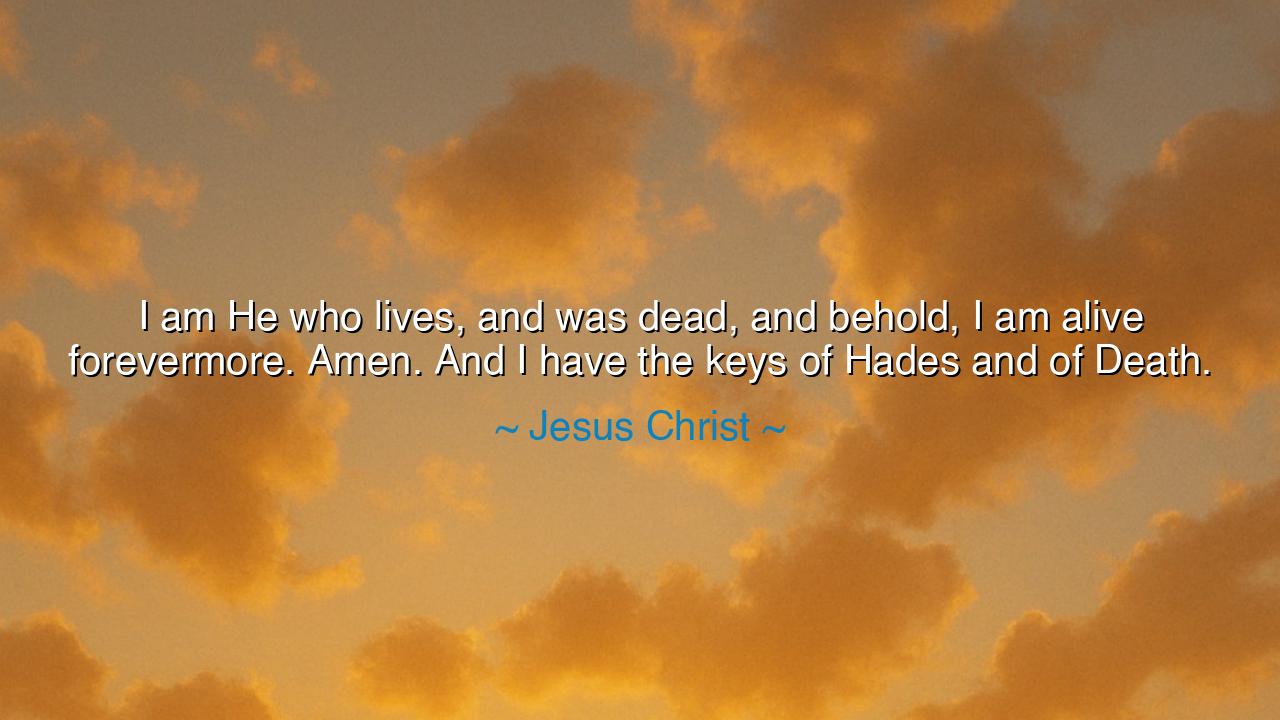
I am He who lives, and was dead, and behold, I am alive
I am He who lives, and was dead, and behold, I am alive forevermore. Amen. And I have the keys of Hades and of Death.






The words of Jesus Christ, “I am He who lives, and was dead, and behold, I am alive forevermore. Amen. And I have the keys of Hades and of Death,” thunder from the opening chapter of the Book of Revelation, spoken to the Apostle John as a divine revelation on the island of Patmos. These are not merely words of comfort—they are words of cosmic power, words that shake the foundations of fear and darkness. In this declaration, Christ reveals Himself not only as the Risen One, but as the eternal Lord of Life, the conqueror of Death, and the Master over the unseen realms. Here, He stands not as a prophet among men, but as the living embodiment of immortality, the bridge between the mortal and the divine.
In saying, “I am He who lives,” Jesus proclaims the fullness of existence itself. Life, in its purest form, does not belong to men, nor to angels—it belongs to God, who is life eternal. When He says, “I was dead,” He speaks to the greatest paradox of faith: that the infinite One entered the finiteness of death, and through that descent, destroyed death’s dominion. The Resurrection is not merely the rising of a body—it is the victory of love over oblivion, the triumph of light over shadow. And when He declares, “Behold, I am alive forevermore,” He announces that the gates of mortality have been shattered, that death itself has become the servant of life.
The phrase “I have the keys of Hades and of Death” reveals Christ’s authority over the deepest fears of humankind. In ancient thought, Hades represented the underworld—the silent domain where souls were bound after death. The key, in this imagery, is the symbol of power, of sovereignty, of dominion. To hold the keys of death is to command it, to decide when it opens and closes. Thus, Christ proclaims that no longer does the grave hold authority over humanity; no longer is death a prison without exit. By His death and resurrection, He has become the Keeper of the Keys—the one through whom every soul may pass from death into eternal life.
Throughout history, countless souls have drawn strength from these words, finding courage where terror once reigned. Consider the story of Polycarp, the aged bishop of Smyrna, who faced execution in the second century. When ordered to deny Christ to save his life, he replied, “Eighty and six years have I served Him, and He has never wronged me. How then can I blaspheme my King who saved me?” The flames rose, but Polycarp did not tremble, for he believed what his Lord had spoken—that death had lost its sting, that life eternal was already his. In the face of fire, he knew the truth of these words: “I am alive forevermore.” His body perished, but his faith became immortal.
The ancients knew that fear of death enslaves the soul. It binds men to despair, to greed, to violence—each a desperate attempt to outrun the inevitable. But Christ’s victory over death freed humanity from that bondage. His words remind us that the journey through the grave is not the end but the passage to renewal. Just as winter yields to spring, and seed must die to give birth to new life, so too does the spirit transcend its mortal shell. The keys of Hades are not tools of terror—they are symbols of liberation, promising that the darkness we dread is not eternal, for the One who holds the keys is love itself.
This teaching calls for a transformation of how we live. To believe that life conquers death is to live with courage, compassion, and purpose. It means no act of kindness is wasted, no suffering endured in vain, no love lost forever. When we recognize that death no longer reigns, we are free to live as true children of eternity—fearless, humble, and radiant with hope. We are called to walk in the same spirit that conquered the grave: to forgive, to heal, to serve, to love without measure. For every act of goodness, however small, participates in the eternal life of the One who said, “I am He who lives.”
The lesson, then, is this: fear not the shadow of death, for its power has been broken. Christ holds the keys, and through Him, life flows unending. When despair whispers that all is lost, remember that life eternal has already been won; when darkness falls, remember that it is but the veil before dawn. So live with the heart of resurrection—rising from failure, forgiving the unforgivable, finding light even in grief. For to follow Him is to walk not toward death, but through it, into the boundless radiance of everlasting life.
Thus, hear and remember these words, as they were spoken to the trembling disciple upon Patmos, and now to every heart that seeks hope: “I am He who lives, and was dead, and behold, I am alive forevermore.” Let them be your shield in the hour of fear and your song in the valley of shadows. For the One who holds the keys of Hades and Death holds also the keys to your deliverance—and through Him, life shall never end.






AAdministratorAdministrator
Welcome, honored guests. Please leave a comment, we will respond soon